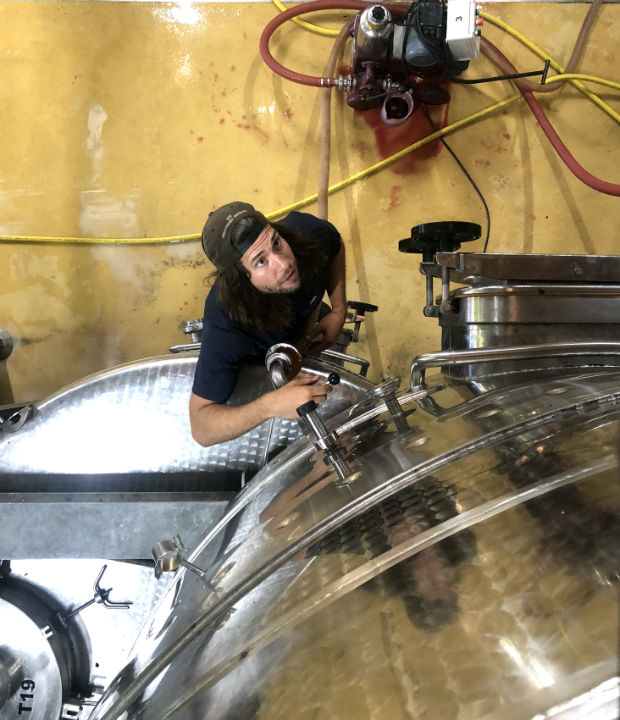120km from Cape Town lies a glorious valley in Walker Bay, Hermanus. The Hemel-en-Aarde valley has been monikered by its celestial name for over 200 years. In this picturesque part of the world, rolling vineyards meet a thunderous ocean. Nothing could be more apt than the moniker ‘Heaven-and-Earth’.
Peter Finlayson, Founder of the Hemel-en-Aarde’s Bouchard Finlayson Winery has an innate knowledge of the history and viticulture of the valley. Widely regarded as a pioneer of South African Pinot Noir and Chardonnay, Peter Finlayson and business partner Michael Clark founded Bouchard Finlayson in partnership with Frenchman, Paul Bouchard in 1989. In 2000, the Tollman family purchased the wine farm with the proviso that Peter would remain at the helm of the farm as winemaker and General Manager.
Peter, mentored a successor in winemaker, Chris Albrecht, as he spread his seasoned wings. With extensive experience in New Zealand and France, and impressive accolades at a winery in Franschhoek, Chris heeded the call to head to the Hemel-en-Aarde Valley. Although Chris started his career at Bouchard Finlayson in 2010, he was promoted to head of production from the 2017 harvest.
ALSO READ: SA wine farms are abuzz: Scenes from the 2019 harvest
At Bouchard Finlayson, over 185 000 bottles of premium wine are produced annually. 25 hectares of the 125-hectare property are under vine. Apart from winemakers, few people are more intimately au fait with the vines than the vineyard workers who rise early to pick grapes during harvest season.
“You are constantly on your knees and getting up, it’s hard on your back,” Mortimer Lee, Estate Manager explains the backbreaking process of picking grapes.
Generally, the vines are trellised in three perpendicular rows along wires. The grapes grow along the bottom trellising wire, which means that the pickers either squat or kneel to hand-pick grapes, then rise to their feet to lift picking bins filled with grapes. According to Mortimer, throughout the year, there are 25 permanent workers on the farm who are specialist workers, like supervisors, tractor drivers and cellar hands. However, during harvest season temporary workers are sourced as additional pickers during the roughly 6-week-long harvest season.
The process of picking grapes is incredibly orderly and intimidating. Mortimer says, “you come here on day one of harvest and all you see is row upon row of an unpicked vine and it is daunting. ”With 33 pickers who face the daunting vines daily, every grape must be picked or discarded before harvest is complete.
Over an hour and a half of harvest, 3 tons or over 0.35 hectares of vines are picked by 33 pickers who gently remind one another to, “watch your fingers.”
Lindie Hansem is one of the farm’s permanent workers, who, besides working as a picker during harvest season, also works at the sorting table. Lindie inspects the quality of grapes and sorts the good berries from the less desirable. Undesirable berries include those that are overripe (akin to raisins) and those that have not yet ripened (for red varietals like Sangiovese, these grapes are still red and have not turned black as yet).
Lindie is tasked with being Goldie Locks, she only selects berries that are just right. Lindie (now aged 28), was 21-years-old when she first started working at the farm and is commemorating her eighth harvest in 2019. A mother of a 7-year-old and a 6-month-old, Lindie gets up at 5 am and arrives in the vineyard to begin harvesting at 7.30 am. She says tea time is at 9 am and “almal sit saam.” She heads home for lunch at 1 pm before heading to the sorting table until 5 pm.
As 30 odd people quietly pull the lower leaves off of the vines, before cutting bunches of grapes off, the pickers’ mutual respect for one another shines. Each gives the other a section of a trellised vine to work on and after 4 weeks of back-breaking work, none encroaches on the other’s section. Wine is said to be made in the vineyard, and vineyard workers bear the weighty responsibility of bringing high-quality grapes into the cellar.
With the vines susceptible to diseases such as erinose (small, non-fatal bumps in the vines due to mites that are controlled with Sulphur spray), vineyard care is paramount. Chris Albrecht says that buying in grapes costs roughly R10 000 per ton and each ton results in roughly 700 bottles. In the cellar, Chris works with an assistant winemaker, as well as two overseas interns in a frenzy to turn tons of grapes into wine.
One of his interns calls out: “mother nature won’t wait” as Chris hoists Chardonnay grapes into the crush pad on a forklift. The white grapes are mechanically de-stemmed and crushed before being mechanically pumped into tanks. From the press to the tank, Sauvignon Blanc settles in 24-48 hours. The winemaker and his assistant monitor sugar and temperature using fermentation charts.
ALSO READ: 7 Wine terms every wine lover should know
Chris explains, “if you want to control the rate of fermentation, you control the temperature.”While a hive of technical activity turns the winemaker’s cellar into a chemistry lab, Chris reiterates the necessity of the work done in the vineyard.“Wine is made in the vineyard,” Chris says. “You can make an average wine from excellent fruit, but you can’t make excellent wine from average fruit. It’s like putting on make-up, you’re not going to create beauty from an average starting point.”
Knowing what goes into making your favourite bottle of vino makes you appreciate it even more! Sign up to Food24’s new wine club – where you are sent different wines each month based on your favourite varietals.
Images via Tshepang Molisana

